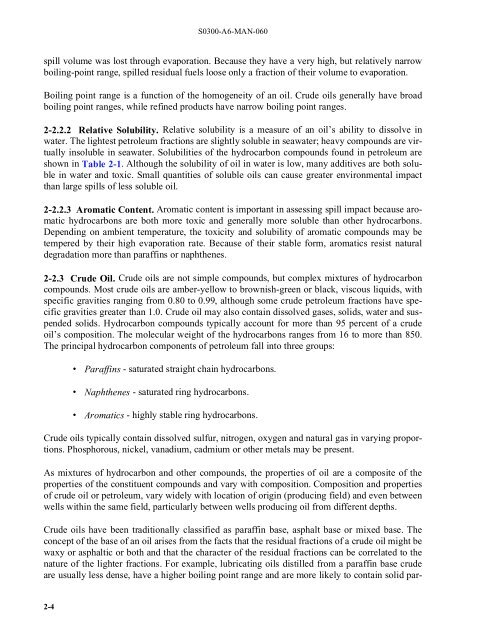U.S. Navy Ship Salvage Manual Volume 6 - Oil Spill Response
U.S. Navy Ship Salvage Manual Volume 6 - Oil Spill Response
U.S. Navy Ship Salvage Manual Volume 6 - Oil Spill Response
- No tags were found...
You also want an ePaper? Increase the reach of your titles
YUMPU automatically turns print PDFs into web optimized ePapers that Google loves.
S0300-A6-MAN-060spill volume was lost through evaporation. Because they have a very high, but relatively narrowboiling-point range, spilled residual fuels loose only a fraction of their volume to evaporation.Boiling point range is a function of the homogeneity of an oil. Crude oils generally have broadboiling point ranges, while refined products have narrow boiling point ranges.2-2.2.2 Relative Solubility. Relative solubility is a measure of an oil’s ability to dissolve inwater. The lightest petroleum fractions are slightly soluble in seawater; heavy compounds are virtuallyinsoluble in seawater. Solubilities of the hydrocarbon compounds found in petroleum areshown in Table 2-1. Although the solubility of oil in water is low, many additives are both solublein water and toxic. Small quantities of soluble oils can cause greater environmental impactthan large spills of less soluble oil.2-2.2.3 Aromatic Content. Aromatic content is important in assessing spill impact because aromatichydrocarbons are both more toxic and generally more soluble than other hydrocarbons.Depending on ambient temperature, the toxicity and solubility of aromatic compounds may betempered by their high evaporation rate. Because of their stable form, aromatics resist naturaldegradation more than paraffins or naphthenes.2-2.3 Crude <strong>Oil</strong>. Crude oils are not simple compounds, but complex mixtures of hydrocarboncompounds. Most crude oils are amber-yellow to brownish-green or black, viscous liquids, withspecific gravities ranging from 0.80 to 0.99, although some crude petroleum fractions have specificgravities greater than 1.0. Crude oil may also contain dissolved gases, solids, water and suspendedsolids. Hydrocarbon compounds typically account for more than 95 percent of a crudeoil’s composition. The molecular weight of the hydrocarbons ranges from 16 to more than 850.The principal hydrocarbon components of petroleum fall into three groups:• Paraffins - saturated straight chain hydrocarbons.• Naphthenes - saturated ring hydrocarbons.• Aromatics - highly stable ring hydrocarbons.Crude oils typically contain dissolved sulfur, nitrogen, oxygen and natural gas in varying proportions.Phosphorous, nickel, vanadium, cadmium or other metals may be present.As mixtures of hydrocarbon and other compounds, the properties of oil are a composite of theproperties of the constituent compounds and vary with composition. Composition and propertiesof crude oil or petroleum, vary widely with location of origin (producing field) and even betweenwells within the same field, particularly between wells producing oil from different depths.Crude oils have been traditionally classified as paraffin base, asphalt base or mixed base. Theconcept of the base of an oil arises from the facts that the residual fractions of a crude oil might bewaxy or asphaltic or both and that the character of the residual fractions can be correlated to thenature of the lighter fractions. For example, lubricating oils distilled from a paraffin base crudeare usually less dense, have a higher boiling point range and are more likely to contain solid par-2-4
















